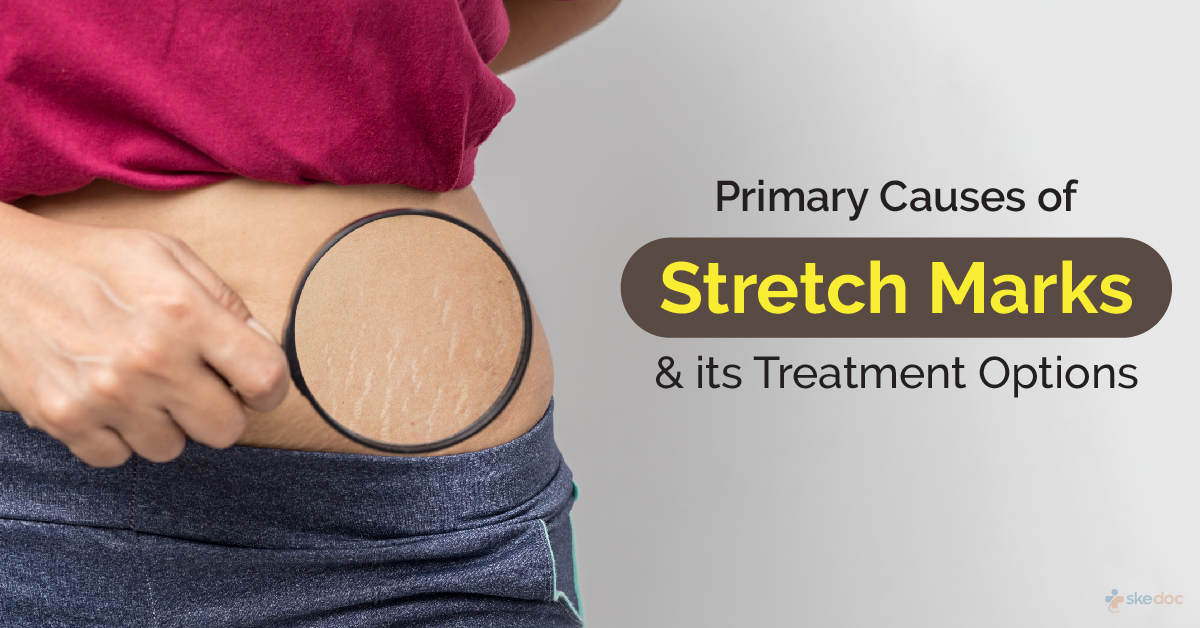Allergy
Blood Diseases
Bone & Joints
Brain
Cancer
Child Care
Cosmetic Surgery
Diabetes
Endocrinology
ENT
Eye
Gen Medicine
General Surgery
Heart
Kidney
Lifestyle
Liver & Digestive
Lung
Men’s Health
Mental health
Physiotherapy
Rheumatology
Skin and hair
Sleep Disorders
Spine
Transplant
Women Health
Thyroid
Vascular Surgery
Stretch Marks

What are Stretch Marks?
Stretch Marks, also known as Striae, are a type of scars on the skin that form when the skin stretches. They appear as multiple lines on the skin and are different in colour and texture compared to normal skin. Stretch marks can be purple, bright pink or lighter than the surrounding skin colour. The marks can appear slightly raised above the skin, but mostly they appear as atrophic distended lines.
Alternate names
- Striae distensae
- Striae rubra( red in colour)
- Striae gravidarum (due to pregnancy)
- Striae alba ( white in colour)
- Striae nigra ( black in colour)
- Striae caerulea( blue in colour)
Is Stretch Marks a Medical Emergency?
Stretch Marks are not a medical emergency.
Causes
The primary cause of stretch marks is the stretching of the skin. Stretching of the skin can happen
- During pregnancy, when the abdomen enlarges
- Rapid weight gain or weight loss
- After a sudden growth spurt in teenagers
- Weight training exercises that could cause rapid muscle growth
- Long-term application of topical corticosteroid cream
- Due to hormonal issues
The other reason for developing stretch marks is increased cortisone hormone levels. Cortisone is a hormone produced by adrenal glands (glands present above the kidneys). Increased cortisone hormone levels lead to skin elasticity loss by weakening the elastic fibres in the skin. Loss of skin elasticity leads to the development of stretch marks.
Risk Factors
Certain factors can increase the risk of developing stretch marks, include
- Stretch marks develop on the abdomen, especially during the last trimester
- Long-term use of corticosteroid cream on the skin
- Overweight
- Rapid weight gain or weight loss
- Previous family history
- Presence of adrenal gland disorders such as Cushing’s syndrome and certain connective tissue disorders like Marfan’s syndrome, Ehlers-Danlos syndrome etc.
Symptoms & Signs
They appear as zigzag lines or streaks on the skin, especially on the stomach, breasts, hips, and buttocks. Initially, they may be red, purple, pink, reddish-brown, or dark brown. Over time, the colour fades away, appearing lighter than the skin colour. They appear as raised lines on the skin and sometimes are itchy. Streaks cover most of the area on the skin.
Investigations/ Diagnosis
No specific diagnostic test is required to confirm the presence of the Stretch marks. Diagnosis is made by physically examining the skin and reviewing an individual's medical and family history. If there is a suspicion that stretch marks might result from any other underlying illness, blood, urine, and some imaging tests are performed.
Treatment Options
Medical treatment
No specific self-care or therapy is required to treat stretch marks. They fade away over time; however, they do not disappear completely. Treatment is available only to improve its appearance and also helps alleviate itching if present.
- Topical retinoid creams are used to improve the appearance and texture of Stretch Marks. Retinoid cream is derived from vitamin A. Retinoids help to rebuild collagen in the skin and improve skin elasticity.
- Glycolic acid creams are also used in the treatment of Stretch Marks
- Moisturizers can help to decrease the itching sensation
Interventional treatment including surgery and indications for surgery/ Surgical treatment
Cosmetic procedures like chemical peels, laser therapy, micro-needling, MNRF, and carboxy therapy can help to treat Stretch Marks. These therapies help to generate new collagen growth and improve the elasticity function of the skin. The outer layer of the skin is removed, and a new smoother, firmer, toned skin is formed.
Role of Diet/ Exercise/ Lifestyle changes/ Preventive measures
There are no specific ways to prevent stretch marks. Marks caused due to pregnancy cannot be prevented. However, some measures can be followed to maintain good skin:
- Maintaining adequate weight with regular exercise and a healthy diet
- Consume foods rich in vitamins C, D, E, zinc, and proteins
- Treat new Stretch Marks with available treatments. However, the best results can be achieved when stretch marks are in the initial stage.
- Stay hydrated by drinking a lot of fluids
Complications
Except for affecting the cosmetic appearance of the skin, stretch marks do not lead to any complications.
Prognosis
Stretch Marks are permanent. No effective treatments are available to cure stretch marks completely, and preventing them is also difficult. Nonetheless, stretch marks are not considered a serious skin condition or disease. They fade to become less noticeable with time.
When to contact the doctor? / How to identify the complications?
Usually, stretch marks are not of serious concern. They are not painful or harmful. However, medical consultation is necessary if they affect the skin's appearance.
Indications for hospitalization
Treatment of stretch marks does not require any hospitalizations. Light or laser therapies or other cosmetic procedures performed in treating Stretch Marks can also be performed on an outpatient basis.
Suggested clinical specialists/ Department to consult for this condition
- Dermatology
Was this article helpful?
YesNo
Comments





